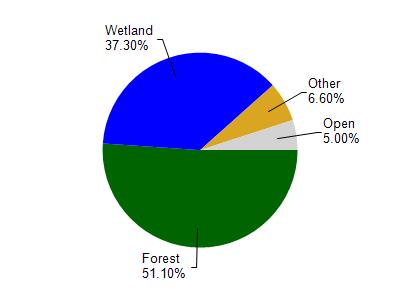Oneida
No
No
No
Fish and Aquatic Life
Overview
George Lake, in the Pelican River Watershed, is a 442.67 acre lake that falls in Oneida County. This lake is managed for fishing and swimming and is currently not considered impaired.
Date 2011
Author Aquatic Biologist
Historical Description
Source: 1966, Surface Water Resources of Oneida County George Lake, T36N, R9E, Section 14 Surface Acres = 434.3, S.D.F. = 2.12, Maximum Depth = 26 feet.
A soft water drainage lake having slightly acid light brown water of moderate transparency. Sand is the chief littoral material (35 percent) with gravel (20 percent), muck (15 percent) and rock (10 percent). The shoreline is predominantly upland (90 percent) with a coniferous-bog wetland adjoining a limited portion of the lake basin. The fish species inhabiting this lake are muskellunge, northern pike, walleye, largemouth bass smallmouth bass, perch, bluegill, crappie, rock bass, pumpkinseed, bullhead and suckers. Public access with parking is available. Fifteen resorts, two private campgrounds and 90 dwellings are located on the shore. A picnic site is also located on this lake. Diving ducks make use of this lake on their fall migration.
Date 1966
Author Surface Water Inventory Of Wisconsin
General Condition
George Lake (1569600) was assessed during the 2016 listing cycle; total phosphorus sample data were clearly below 2016 WisCALM listing thresholds for Recreation use and Fish and Aquatic Life use. Chlorophyll sample data were clearly below FAL use listing thresholds and did not exceed REC listing thresholds. This water is meeting these designated uses and is not considered impaired.
Date 2015
Author Ashley Beranek
Condition
Wisconsin has over 84,000 miles of streams, 15,000 lakes and milllions of acres of wetlands. Assessing the condition of this vast amount of water is challenging. The state's water monitoring program uses a media-based, cross-program approach to analyze water condition. An updated monitoring strategy (2015-2020) is now available. Compliance with Clean Water Act fishable, swimmable standards are located in the Executive Summary of Water Condition in 2018. See also the 'monitoring and projects' tab.
Reports
Recommendations
Monitor Invasive Species
Monitor Water Quality or Sediment
Social Survey of Residents or Users
Informational Meetings
Shoreland Monitoring, Assessment, Inventory
Shoreland Monitoring, Assessment or Inventory
Monitor or Assess Watershed Condition
Aquatic Plant Monitoring or Survey
Watershed Mapping or Assessment
Monitoring Ecosystem
Management Goals
Wisconsin's Water Quality Standards provide qualitative and quantitative goals for waters that are protective of Fishable, Swimmable conditions [Learn more]. Waters that do not meet water quality standards are considered impaired and restoration actions are planned and carried out until the water is once again fishable and swimmable
Management goals can include creation or implementation of a Total Maximum Daily Load analysis, a Nine Key Element Plan, or other restoration work, education and outreach and more. If specific recommendations exist for this water, they will be displayed below online.
Monitoring
Monitoring the condition of a river, stream, or lake includes gathering physical, chemical, biological, and habitat data. Comprehensive studies often gather all these parameters in great detail, while lighter assessment events will involve sampling physical, chemical and biological data such as macroinvertebrates. Aquatic macroinvertebrates and fish communities integrate watershed or catchment condition, providing great insight into overall ecosystem health. Chemical and habitat parameters tell researchers more about human induced problems including contaminated runoff, point source dischargers, or habitat issues that foster or limit the potential of aquatic communities to thrive in a given area. Wisconsin's Water Monitoring Strategy was recenty updated.
Grants and Management Projects
Monitoring Projects
| WBIC | Official Waterbody Name | Station ID | Station Name | Earliest Fieldwork Date | Latest Fieldwork Date | View Station | View Data |
|---|
| 1569600 | George Lake | 10004507 | George Lake | 4/7/1981 | 8/14/2025 | Map | Data |
| 1569600 | George Lake | 443125 | George Lake - Deep Hole | 8/9/1973 | 8/24/2025 | Map | Data |
| 1569600 | George Lake | 10018873 | George Lake -- Access at Nostalgia Ln | 10/9/2003 | 9/28/2025 | Map | Data |
| 1569600 | George Lake | 443103 | George Lake - Deep Hole | 9/5/1979 | 6/29/2016 | Map | Data |
| 1569600 | George Lake | 443479 | George Lake - McVety Hole | 9/25/2003 | 8/14/2025 | Map | Data |
|

Watershed Characteristics
George Lake is located in the Pelican River watershed which is 264.88 mi². Land use in the watershed is primarily forest (51.10%), wetland (37.30%) and a mix of open (5%) and other uses (6.60%). This watershed has 244.69 stream miles, 8,823.57 lake acres and 59,960.52 wetland acres.
Nonpoint Source Characteristics
This watershed is ranked Not Ranked for runoff impacts on streams, Medium for runoff impacts on lakes and Low for runoff impacts on groundwater and therefore has an overall rank of Low. This value can be used in ranking the watershed or individual waterbodies for grant funding under state and county programs.However, all waters are affected by diffuse pollutant sources regardless of initial water quality. Applications for specific runoff projects under state or county grant programs may be pursued. For more information, go to surface water program grants.